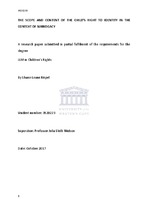| dc.contributor.advisor | Sloth-Nielsen, J. | |
| dc.contributor.author | Rispel, Shane-Leane | |
| dc.date.accessioned | 2018-02-13T07:48:20Z | |
| dc.date.available | 2018-02-13T07:48:20Z | |
| dc.date.issued | 2017 | |
| dc.identifier.uri | http://hdl.handle.net/11394/5703 | |
| dc.description | Magister Legum - LLM | en_US |
| dc.description.abstract | The development of assisted reproductive technology (ART) has radically changed the
landscape of the conventional family. It has permitted a platform for the creation of
families and family structures with tremendous diversity in their demographic
characteristics. It has also changed the way in which individuals become parents. The
advances in medical and scientific fertility treatments have meant that for many the dream
of having a child of their own has now become a real possibility. Public perception and
attitudes towards infertility treatments and more latterly surrogacy has changed
tremendously and becoming increasingly acceptable. While there are those who have
celebrated the advancement in reproductive technologies and potential freedoms that this
may contain, ART has opened the proverbial Pandora's Box amongst scholars and the public
policy makers, principally in the area of rights. | en_US |
| dc.language.iso | en | en_US |
| dc.publisher | University of the Western Cape | en_US |
| dc.subject | Right to identity | en_US |
| dc.subject | Surrogacy | en_US |
| dc.subject | Surrogate | en_US |
| dc.subject | Child rights | en_US |
| dc.title | The scope and content of the child's right to identidy in the context of surrogacy | en_US |
| dc.type | Thesis | en_US |
| dc.rights.holder | University of the Western Cape | |

